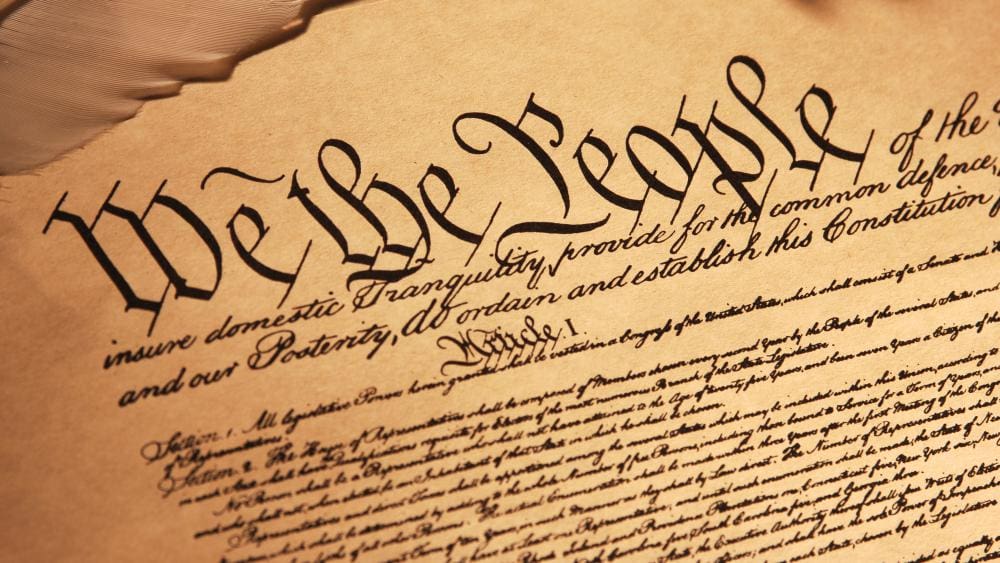The14th Amendment: Unconstitutional Treason or Lawful Ratification?

The 14th Amendment: Unconstitutional Treason or Lawful Ratification?
Exposing the Truth About
America’s Most Controversial Amendment
The Fourteenth Amendment has been a controversial addition to the US Constitution since its ratification in 1868. While the amendment was intended to provide equal protection under the law for all citizens, ensure due process, and grant citizenship to all persons born or naturalized in the United States, how is was proposed and ratified has been called into question.
Some key arguments against the validity of the Fourteenth Amendment include:
It violates the Supremacy Clause of the Constitution by unlawfully expanding federal powers beyond what is outlined in Article 1 Section 8. This violates the intent of the framers to limit federal powers.
It goes against the Kentucky and Virginia Resolutions written by Jefferson and Madison, which argued for limited federal powers and states’ rights.
Issues with the House of Representatives’ adoption of the amendment, including the exclusion of representatives from Southern states.
Failure to properly ratify the amendment with the requisite number of state legislatures.
Adoption by state legislatures unlawfully formed under Reconstruction.
Exclusion of senators from Southern states for the Senate adoption vote.
Lack of submission to the President for approval as required by Article 1 Sec. 7.
This brief will explore each of these arguments against the legitimacy of the Fourteenth Amendment in detail. The questionable means by which this highly impactful amendment was added calls the validity of its ratification into question.
Supremacy Clause Argument
The strongest argument against the validity of the 14th Amendment is that it violates the “Supremacy Clause” of the U.S. Constitution Article 6 Paragraph 2. The Supremacy Clause states that the Constitution is the supreme law of the land. The original Constitution and Bill of Rights created a citizen of the several states in Article 4 Section 2. This original state citizen was not a corporation, as later defined in the 14th Amendment.
The 14th Amendment created a new national citizenship and granted the federal government expanded powers. It did this without proper ratification according to the process defined in the original Constitution. Therefore, the 14th Amendment violates the Supremacy Clause by overriding and changing the original Constitution without lawful authority. Any law or amendment that conflicts with the original Constitution is null and void. The 14th Amendment should be considered unconstitutional based on the Supremacy Clause.
Madison’s and Jefferson’s Argument Against the 14th Amendment
James Madison and Thomas Jefferson argued against the 14th Amendment in their Kentucky and Virginia Resolutions of 1798, stating that it violates the core principles of limited government as intended by the Founding Fathers.
The 14th Amendment expanded federal power by granting citizenship rights, due process rights, and equal protection rights. However, Madison and Jefferson believed strictly limiting federal power was essential to protect individual liberty and state autonomy.
The Resolutions contend the Constitution only granted the federal government certain enumerated powers in Article 1 Section 8. Any expansion requires proper constitutional amendment following Article 5 procedures.
By violating the Founders’ vision of limited government, the 14th Amendment undermines the Constitution’s integrity. Its ratification excluded Southern states, further conflicting with the amendment process.
Overall, Madison and Jefferson would view the 14th Amendment as unconstitutional based on their strict constructionist interpretation of federal power. They argued unilaterally expanding government authority endangers freedom.
House Adoption Issues
The 14th Amendment was adopted by the House of Representatives unconstitutionally. Ten Southern states were excluded from the vote after the Civil War, even though they had been readmitted to the Union. The 39th Congress claimed these states did not have lawful governments, so they were put under military rule and excluded from voting on the 14th Amendment.
New state governments were then formed under military authority in violation of the Constitution. Once these new puppet state governments ratified the 14th Amendment, they were allowed congressional representation again. However, forming new state governments without the consent of the existing state legislatures and excluding lawfully reconstituted states from voting are direct violations of Article IV Section 3 and Article V of the Constitution. The House adoption of the 14th Amendment was therefore unconstitutional.
State Ratification Issues
Many states rejected the 14th Amendment between the time it was submitted to the states in June 1866 and when it was declared ratified in July 1868. Specifically, the legislatures of the following states officially rejected the amendment:
Arkansas
Texas
Georgia
Florida
Alabama
North Carolina
South Carolina
Kentucky
Virginia
Louisiana
Delaware
Maryland
Mississippi
Additionally, the state legislatures of Arkansas, North Carolina, Louisiana, South Carolina, Alabama, and Georgia that voted to reject the amendment were illegally removed by Congress. New state governments were then formed in these states under the Reconstruction Acts. These new state legislatures consisted of unelected individuals and did not have lawful status. However, these new legislatures then voted to ratify the 14th Amendment under duress.
The Reconstruction Acts allowing the removal of state governments and creation of new legislatures were unconstitutional, as was the ratification of the 14th Amendment by these new state governments. The amendment was not adopted in accordance with Article V of the Constitution, which outlines the proper process for ratifying constitutional amendments.
Senate Adoption Issues
The Constitution provides that the Senate shall be composed of two senators from each state (Article 1, Section 3). It also states that no state shall be deprived of equal suffrage in the Senate without its consent (Article 5). However, 23 senators from southern states were excluded from the Senate during the vote to adopt the 14th Amendment. This violated the Constitution’s requirements for equal representation from all states in the Senate.
The southern states had declared secession and formed the Confederate States of America during the Civil War. But after the war, and before the 14th Amendment vote, they had been readmitted to the Union. Despite this, their senators remained excluded from Congress. This unfairly skewed the balance of power in favor of northern Republican states in the vote to approve the 14th Amendment.
Excluding nearly a quarter of the Senate from debate and voting was clearly unconstitutional. The Constitution is clear that every state shall have equal representation and suffrage. This infringement during a major Constitutional change prevented a true national consensus. It calls into question whether the 14th Amendment reflected the will of the entire nation, as amendments are intended to. The improper adoption cast doubt on the 14th Amendment’s legitimacy from the beginning.
Presidential Issues
The 14th Amendment was not submitted properly to the President for approval, as required by the Constitution. President Andrew Johnson warned Congress multiple times that their actions regarding Reconstruction would make the law itself unlawful, creating a de facto government.
Johnson vetoed the Reconstruction Acts, arguing they were unconstitutional. However, his vetoes were overridden by Congress. When the proposed 14th Amendment was submitted to the states for ratification, it was never submitted to the President for approval.
Article I, Section 7 of the Constitution states that for a bill or resolution to become law, it must pass both Houses of Congress and be submitted to the President for signature or veto. If the President vetoes, it can still become law if 2/3rds of both Houses override the veto.
The 14th Amendment resolution was submitted directly to the states, bypassing Presidential approval. President Johnson stated: “I cannot believe that any court, in full possession of its faculties, could honestly hold that the amendment was properly approved and adopted.”
Ignoring the President’s warnings about the unconstitutionality of Reconstruction created a de facto unlawful government, operating outside the proper process defined in the Constitution.
California’s Vote Was Unlawfully Changed
California originally declined to adopt the 14th Amendment in 1868. This is evidenced by the California Journal of the Assembly on March 2nd, 1868 declining adoption on page 601. Then on March 17th, 1868 in the California Journal of the Assembly on page 758, the California House again formally declined to adopt the 14th Amendment as recorded at 15 Stat. 707.
However, Secretary of State William H. Seward stated that while Ohio and New Jersey legislatures had passed resolutions withdrawing their consent for the ratification of the 14th Amendment, both of those states were still counted in the ratification. Yet California’s earlier vote declining the amendment was changed without their consent or a resolution from California.
This shows that California’s vote on the 14th Amendment was unlawfully changed without the consent or action of the state itself. The amendment was only ratified by one vote, so without California’s changed vote, the 14th Amendment would have failed ratification.
Ohio and New Jersey Withdraw Ratification But Are Still Counted
After initially voting to ratify the 14th Amendment, the state legislatures of Ohio and New Jersey later passed resolutions withdrawing their consent for ratification due to the unconstitutional way the amendment passed the Senate.
However, even after Ohio and New Jersey withdrew their ratification, their votes were still counted by the Secretary of State towards the total. In the Secretary of State’s report on ratification, he acknowledged that Ohio and New Jersey had withdrawn ratification but stated they would still be counted.
This means that even though Ohio and New Jersey explicitly withdrew support for the 14th Amendment, their votes were counted as if they had ratified. Since the 14th Amendment was ratified by just one vote, counting the withdrawn votes of Ohio and New Jersey was critical to claiming ratification.
Conclusion
In summary, several issues bring into question the validity of the 14th Amendment:
– The House of Representatives adopted the 14th Amendment questionably, with Southern states excluded from voting.
– Multiple states initially rejected the 14th Amendment when it was presented for ratification. Southern states that later approved it did so under Reconstruction governments of questionable legitimacy.
– The Senate also adopted the amendment in a compromised process, with Southern senators excluded.
– President Andrew Johnson raised objections to the adoption process for the 14th Amendment.
– There were irregularities in how some state’s votes for ratification were handled. California’s rejection was later changed to an approval without explanation.
– Ohio and New Jersey later voted to withdraw their ratification, but their withdrawals were ignored.
With all of these procedural flaws and legal ambiguities, there is a strong argument that the 14th Amendment was never properly added to the Constitution. The amendment fundamentally changed the relationship between federal and state governments and between government and citizens. However, the adoption process betrayed Constitutional principles that cannot simply be ignored for the sake of political expediency.
For these reasons, the 14th Amendment should be regarded as legally invalid. The flaws in its ratification process undermine its legitimacy as a Constitutional amendment.








You must be logged in to post a comment.